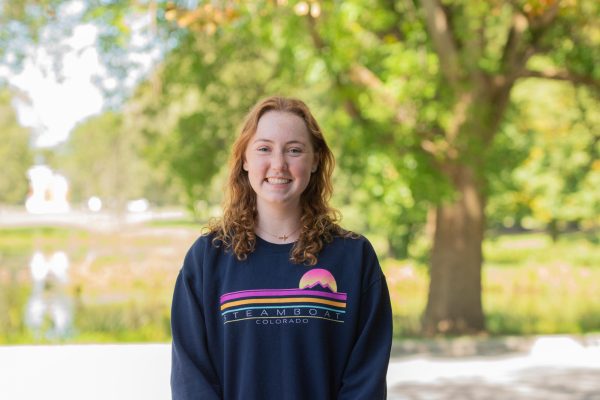Friday Night Film Series Showcases ‘Flee’
Students, faculty and families visiting for Parents Weekend gathered in the Golden Auditorium last Friday to watch “Flee,” a documentary directed by Danish filmmaker Jonas Poher Rasmussen. “Flee” tells the story of Rasmussen’s friend “Amin” (a pseudonym used to protect his anonymity), an Afghani refugee living in Denmark with his partner “Kasper.” The film is primarily animated, showing a stylized version of Rasmussen interviewing Amin interspaced with archival footage of different locations and events described by Amin. “Flee” has garnered critical acclaim, winning the 2021 World Cinema Grand Jury Prize for a Documentary at the Sundance Film Festival.
Mary Simonson, associate professor of film and media studies and women’s studies, introduced the film.
“The film we’re going to see tonight I first encountered at the New York Film Festival last fall when I was in New York… [I] was so fascinated by it and so interested in it that I went actually a couple weeks later to see it at NewFest, which is an LGBTQ festival in New York, as well, and then when we were making our list of films we wanted to bring to campus this semester this was one of the first ones that was on my list,” she said.
Amin’s story begins in Afghanistan, living with his family until the Islamic extremist Mujahideen takes over. Amin, his siblings and his mother escape to Moscow on visas and spend the next few years experiencing life as outsiders, constantly targeted by the police and fighting to secure amnesty in a safer country. After many harrowing journeys, Amin makes it to Denmark alone. Separated from his family, he does whatever it takes to adapt and survive in his new home.
Throughout his life, Amin constantly grapples with his attraction to men. He was born into a traditional Afghani society that lacks the vocabulary to even describe homosexuality, and views it as shameful. His path to safety in Denmark is also his path to accepting himself. The documentary interrogates how an “obligation to family” and feeling like a “burden” can complicate what “home” means, and how Amin comes to define what “home” means to himself.
The animated medium through which Amin’s story is told adds a certain depth to the film, lending itself to artistic interpretations of events that would not be possible in a traditional documentary.
Junior Charlotte Louks, an attendee whose studies are partially concentrated in film and media studies, remarked on how the medium of the documentary shaped her interpretation.
“I thought it was really interesting to have an animated movie as a documentary style, because the creators can take a lot of creative liberties with that,” Louks said. “So I was wondering about the tensions between not being able to be in the film but to have the film be about you and the ethical implications of that.”
Senior Linda Wang also attended the screening and commented on the depth of the film.
“The film was just so intense, just traveling through, or taking us through his journey of fleeing as a refugee, and there were so many twists and turns,” Wang said. “In a way the visuals kind of made it easier for us to digest what was happening.”
In her introduction, Simonson elaborated on the entanglement of Amin’s overlapping identities and experiences:
“It traces his complex journeys and that’s both a geographical journey that he’s making as he is trying to negotiate life as a stateless migrant and get to a safe place, but [it is also a] psychological and emotional journey as he comes to terms with his own queerness, as he is thinking about his status as an exile, negotiating relationships with members of his family […] also his own difficulties thinking about the future and sustaining relationships.”

LJ Coady is a junior from Houston, TX concentrating in political science with minors in history and religion. She has previously served as a writer for...






